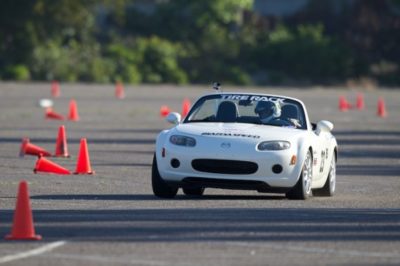Beyond good tires and a competition alignment, shock and anti-roll bar substitutions make for a competitive package.
When we discussed some general SCCA Solo Street class setup previously, along with some RX-8-specific tips, we noted that after the car, tires and driver, everything else is fine tuning with increasingly smaller gains. That wisdom came from Chris Harvey who in addition to being a nationally competitive autocrosser, is also The Tire Rack’s brand manager for Brakes & Suspension. That said, there are some of those fine-tuning things that will help a driver get faster once he or she is driving at the limit.
For setup on just about any car, the maximum amount of negative camber one can achieve through the OE adjustments is usually the way to go. Toe-out, which can help the car turn, will depend largely on the platform. For the MX-5, most drivers prefer a bit of toe out to make the car turn-in just a bit better.
Harvey notes that some models are a better basis for an autocrosser than others.
“Currently, the car I feel to have [in C Street class] is what’s considered the NC2 version, ’09 and up MX-5 with the Touring package, which gives you the 6-speed transmission and limited-slip differential,” he says. “Inside the Touring package, there is an option for the sport suspension; the giveaway for that is the yellow Bilstein dampers that are included as the OE package. That combination in C street is the preferred MX-5 spec to have as a starting point.” Harvey’s MX-5 finished second with Chris Fenter driving and fourth with Harvey at the wheel at the 2014 SCCA The Tire Rack Solo National Championships.
Being such a popular competition car, there are many choices for MX-5 aftermarket parts. While there are racing shock absorbers that can be adapted to the car, that is going a bit overboard. Something like an off-the-shelf Koni with compression and rebound adjustments is the more standard choice. It also keeps everything in the same position and you don’t have to worry about spring perches being off and being disqualified due to ride height issues. It will also save a lot of money.
“The MX-5 has always been fairly easy to set up; it’s a pretty easy formula,” says Harvey. “You maximize the alignment settings and then put on a quality aftermarket shock. We run a bit of a non-traditional setup with our anti-roll bars. We’re allowed to change the front or rear anti-roll bar and, for our particular application, we’ve chosen to replace the rear bar with a stiffer bar. That particular part of the setup is pretty non-traditional for a rear-wheel drive car. Most people will go after the front anti-roll bar and add roll stiffness up there.”
Using those setups will get you pretty close to optimum. However, the MX-5 is pretty good right out of the box. With competitive tires and a proper alignment, the car is well on its way to being a winning package. The shocks and anti-roll bars just get you that much closer.


 ACCESSIBILITY
ACCESSIBILITY